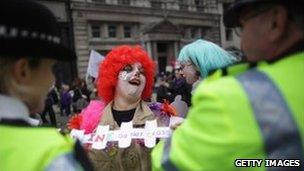'Cuts march police too focused on kettling' - Liberty
- Published
- comments

Senior police officers focused too much on "kettling" during the march against government spending cuts last month, human rights campaigners have said.
A review by 120 legal observers from Liberty said the containment tactic was "under near constant consideration" when potential trouble spots emerged.
It said the tactic undermined trust between peaceful protesters and police.
But it also said the police response to the TUC march in London was "in general proportionate".
Liberty was invited to observe the march by the TUC and Scotland Yard.
Kettling is a police tactic in which protesters are contained in one area by a cordon of officers.
Liberty's report and the observers' role was restricted to the policing of the official TUC "March for the Alternative" event, on 26 March.
"It was not within our remit to observe the policing of events after the TUC march, or completely extraneous to it," the observers say.
A total of 201 arrests were made on the day but these were at protests separate from the official anti-government cuts rally. In Piccadilly, shops and banks were attacked, and damage was caused to the Ritz hotel.
Most of the arrests - 145 - were made after campaign group UK Uncut staged a sit-in at a luxury store Fortnum & Mason in protest over alleged tax avoidance by part-owners of the business.
Trouble also flared in central London in Oxford Street and Trafalgar Square.
'Restrained and proportionate'
The legal observers were posted along the march, which was the biggest trade union event for 20 years, and the biggest protest in London since the 2003 anti-war march.
The TUC estimated that the five-hour march attracted between 250,000 and 500,000 people, with 4,500 police officers involved in the whole operation.
The report said there was "no doubt that the official trade union-led demonstration was overwhelmingly civil, peaceful and good-natured and that the police response was in general proportionate".
At some points, observers praised the police's restraint when faced with "some provocation".
Shami Chakrabarti, Liberty: "We wonder why it (kettling) is under constant consideration"
However it also criticised the police for "too great a focus of police attention" on kettling.
Liberty's position is that the tactic is fatally flawed by the inevitability of detaining the innocent with the guilty.
But in the police control room there seemed to be "continual expectation that a containment would be imposed at some point".
"The question seemed to be more 'when' than 'if'," it said.
Communication problems
It said protesters had become wary of the possibility of being kettled and it appeared to "seriously to undermine the relationship of trust and confidence between peaceful protesters and the police".
"The possibility of mass containment of peaceful protesters has undoubtedly had a chilling effect on many people's rights to freedom of expression and assembly," it added.
It questioned why such a "blunt, resource-heavy, and logistically difficult tactic" had become "such a favoured tactic in the policing of protest".
The report on the event also said some officers had to use mobile phones because their police radios failed to work properly, hampering their ability to deal with breakaway groups.
Scotland Yard welcomed the report.
Assistant Commissioner Lynne Owens said: "We were faced with the difficult task of striking the right balance between ensuring the vast majority of people were able to peacefully protest whilst managing the small number of criminals intent on disorder.
"In what was a significant and challenging policing operation we welcome Liberty's overall conclusion that the policing was proportionate."
- Published27 March 2011
- Published14 April 2011
- Published9 December 2010
- Published26 March 2011